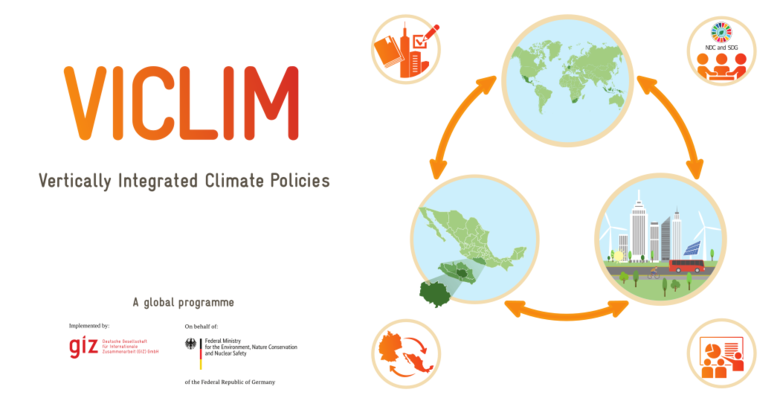Knowledge fuels change
For over a decade, Energypedia has shared free, reliable energy expertise with the world.
We’re now facing a serious funding gap.
Help keep this platform alive — your donation, big or small, truly matters!
Thank you for your support
Mainstreaming Climate Change: Puerto Vallarta PMCC
Background
In 2015, the state of Jalisco adopted its Ley para la Acción ante el Cambio Climático (LACC; Law for Action on Climate Change)[1] that requests all municipalities to have a Programa Municipal de Cambio Climático (PMCC; Municipal Climate Change Programme)[2]. Between 2017 and 2018, the Vertically Integrated Climate Policies Programme (VICLIM) supported Jalisco’s Secretariat of Environment and Territorial Development (SEMADET) in preparing guidelines for municipalities for the development of these PMCCs[3]. And in 2019, in cooperation with the Adaptation to climate change in the tourism sector Programme (ADAPTUR)[4], VICLIM supported the piloting of the guidelines in the coastal city of Puerto Vallarta so that Puerto Vallarta Municipality could further develop and mainstream its climate policy in order to respond to both adaptation and mitigation challenges imposed by climate change.
Process
The development of the Puerto Vallarta PMCC[5] followed the steps given in the official guidelines. It was a test-run and SEMADET wanted to learn from the use of the guidelines and make amendments if needed. However, the process was also handled in a flexible way and from time to time adapted according to interim results during the process, the degree of access to information and the demands of the actors involved.
In brief, the process looked as follows:
- Start-up: The beginning of the process was made public through a public high level event and workshop with the participation of the Municipal President of Puerto Vallarta and the State of Jalisco´s Secretary of the Environment. In the course of this event, the Municipal President also signed the Municipality’s accession to the Global Covenant of Mayors for Climate and Energy (CoM).
- Diagnosis: The first key activities consisted of several climate related studies to lay the foundation for the planning:
- Institutional and social diagnosis, analysing the social, institutional and capacity dimension installed in the municipality in the matter;
- Diagnosis of vulnerability to climate change;
- GHG Inventory: The calculation of the GHG inventory for 2017 was prepared, taking as a reference the methodology proposed in the Global Protocol for Community-wide Greenhouse Gas Emission Inventories (GPC).
- Definition of measures: Based on the diagnosis, a first list of measures was prepared, which were reviewed and enriched in a wider workshop. With the results, the measures were grouped into five thematic axes.
- Prioritization of measures: Workshops were held to complement, characterize and prioritize the measures, as well as bilateral meetings with the different departments of the municipal administration that will be responsible for implementation of measures. A cost-benefit analysis was carried out to identify the most cost-effective measures that represent the greatest benefits to society. The results were presented through a webinar to the target group to socialize the up-to-date results and collect comments for integration.
- Public consultation: When the first draft of the PMCC was available, a public consultation was carried out, the results[6] were published and the comments were integrated. The public consultation stage consisted of three main measures:
- Public display of document: The draft program was available for consultation during this period at the offices of the Sub-directorate of Environment, Puerto Vallarta Municipality.
- Virtual consultation: The virtual consultation process was open between 1 and 30 September and consisted of an online survey accompanied by information material disseminated on both the channels of the SEMADET and Puerto Vallarta Municipality. In this exercise, more than 300 questionnaires were completed and could be considered for the final version of the program.
- Face-to-face forums: In order to have a more participatory process, three exchange forums were held in the format of working tables where the MCCP was presented and a physical and online survey was requested. These forums were strategically held in three different spaces in order to cover a greater number of the population, including the rural sector and young people:
- The 1st Forum was held on 3 September with a participation of 70 people.
- The 2nd Forum on 4 September was attended by 25 people.
- The 3rd Forum was held on 24 September at the University Center of the Coast, University of Guadalajara, with 113 participants.
- Public display of document: The draft program was available for consultation during this period at the offices of the Sub-directorate of Environment, Puerto Vallarta Municipality.
- Finalisation and official adoption: In January 2020, the municipal council adopted the plan. On 29 April 2020, it was officially published in the Municipality’s Gaceta[7].
References
- ↑ https://www.gob.mx/inecc/documentos/ley-para-la-accion-ante-el-cambio-climatico-del-estado-de-jalisco
- ↑ Third Section Chapter II and Article 7 of the transitory provision
- ↑ Check out the guidelines on SEMADET’s website: https://semadet.jalisco.gob.mx/gobernanza-ambiental/cambio-climatico/guia-para-la-elaboracion-o-actualizacion-de-los-programas
- ↑ Both programmes, VICLIM and ADAPTUR, are part of the International Climate Initiative (IKI), funded by the German Federal Ministry for the Environment, Nature Conservation and Nuclear Safety (BMU): https://www.international-climate-initiative.com.
- ↑ The programme can be accessed in issue "Año 02, Número 12, Extraordinaria" on https://www.puertovallarta.gob.mx/2018-2021/Prensa/gaceta.php
- ↑ https://www.puertovallarta.gob.mx/2018-2021/img/publicidad/banner/Informe%20Resultados%20Consulta%20PMCC%20PV.pdf
- ↑ "Año 02, Número 12, Extraordinaria" on https://www.puertovallarta.gob.mx/2018-2021/Prensa/gaceta.php




















